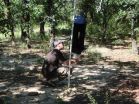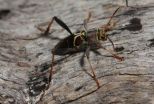(Press-News.org) A longhorned beetle's sexy scent might make a female perk up her antennae. But when the males of several species all smell the same, a female cannot choose by cologne alone.
For these beetles to find a mate of the right species, timing is everything, according to research from a University of Arizona-led team.
"We found that beetles that produce the same pheromone are active at different times of day - and that beetles that are active at the same time of day produce different pheromones," said lead author Robert F. Mitchell, a UA research associate in the department of neuroscience and the Center for Insect Science.
In addition, the team found that some of the beetle species that used the same pheromone stayed true to their species by segregating their mating activity by season of the year.
Many animals use chemicals called pheromones to communicate.
"Smell is an underappreciated sense in people - but when you talk about insects, many 'see' their world in chemicals," said Mitchell, a fellow in the Postdoctoral Excellence in Research and Teaching program. "The most common thing they say with pheromones is, 'I'm looking for a mate.'"
Scientists generally expect each insect species to have its own signature perfume to attract suitable mates. When an insect emits its unique sexual attractant, potential suitors can come a-courting from hundreds of yards away.
However, the family of longhorned beetles presents a puzzle: Many species use the same pheromone, Mitchell said. The situation seemed to contradict the generally accepted idea of one species-one pheromone.
Once the team figured out the various beetle species sent out their scent signals during different parts of the year and at different times of the day, it all made sense, Mitchell said.
"Our research provides a framework for understanding how insects that produce the same pheromone can produce separate signals," he said.
Research on insect pheromones has practical applications, he said. "Pheromones are promising alternatives to pesticides as a means of monitoring and controlling pests."
For example, by baiting traps with the appropriate pheromone, scientists can detect pest insects and monitor their movements. In the Western U.S., pheromones are used to combat a longhorned beetle known as the California prionus that is a pest on hops, Mitchell said.
Using pheromones can also reveal the presence of destructive invasive species such as the Asian longhorned beetle.
The research team's paper, "Cerambycid beetle species with similar pheromones are segregated by phenology and minor pheromone components," is featured on the cover of the May issue of the Journal of Chemical Ecology. A list of the authors is at the end of this story.
As part of his doctoral research at the University of Illinois at Urbana-Champaign, Mitchell studied the chemical attractants for dozens of species of longhorned beetles native to deciduous forests of eastern North America. The beetles bore into the woody stems of dead shrubs and trees.
He later focused on 11 species all attracted to the same chemical. When he and his colleagues put traps baited with that pheromone out in the woods, after 24 hours the traps contained "a big multi-species party."
Initially, Mitchell and his colleagues were baffled. Such a multi-species party didn't make sense, he said, because mating outside one's species doesn't result in viable offspring.
"We asked, 'How do they tell each other apart if they're all producing the same thing?'" he said.
The team had been using traps that collected all the beetles attracted in a 24-hour period.
Senior author Lawrence M. Hanks learned about a rotating trap that could separate beetles by the time of day they entered the trap. That setup allowed the scientists to test whether different species were attracted only at certain times of day.
By using the rotating traps, the researchers found some species visited primarily in the daytime, some came in the early evening and some came at night. Other experiments revealed that the 11 species also searched for mates at different times in the spring.
Finally, the team found that species completely overlapping in time would add additional scents that put off other species while attracting their own.
Some exotic longhorned beetles such as the Asian longhorned beetle have been introduced to the U.S. in packing materials such as wooden pallets.
The scientists write in their paper that if an invasive species used the same pheromone as a complex of native species, the chemicals emitted by the natives might prevent the invaders from finding suitable mates.
"Our native beetles might be unwittingly defending us against invaders," Mitchell said.
INFORMATION:
Mitchell's co-authors are: Peter F. Reagel, now of USDA APHIS PPQ, Laredo, Texas; Joseph C. H. Wong and Linnea R. Meier, University of Illinois at Urbana-Champaign; Weliton Dias Silva, University of São Paulo, Brazil; Judith Mongold-Diers, University of Illinois at Urbana-Champaign; Jocelyn G. Millar, University of California, Riverside; and Lawrence M. Hanks, University of Illinois at Urbana-Champaign.
Alphawood Foundation of Chicago, the U.S. Department of Agriculture, the National Institutes of Health (5K12 GM000708-15) and CAPES-Foundation-Brazil funded the research.
Researcher contact:
Rob Mitchell
rfmitchell@email.arizona.edu
520-621-6631
Media contact:
Mari N. Jensen
520-626-9635
mnjensen@email.arizona.edu
Related Web sites:
UA Department of Neuroscience
http://neurosci.arizona.edu/
Center for Insect Science
http://cis.arl.arizona.edu/
Fast Facts
People with schizophrenia often suffer from cognitive difficulties.
Transcranial direct current stimulation of the brain is widely considered safe and is being studied as a treatment for depression.
In a Johns Hopkins study of people with schizophrenia, transcranial direct current stimulation led to improvements in short-term memory.
Lightly stimulating the brain with electricity may improve short-term memory in people with schizophrenia, according to a new study by researchers at the Johns Hopkins University School of Medicine.
The ...
DALLAS, May 27, 2015 -- African Americans at lower socioeconomic levels, particularly women and younger adults, are at greater risk of heart disease and stroke than those in higher socioeconomic positions, according to research in the Journal of the American Heart Association.
Cardiovascular disease (CVD) is the No. 1 killer of all Americans, but the burden is greater for African Americans. According to the American Heart Association 2014 Statistical Update, nearly half of all African American adults have some form of CVD, and they are twice as likely as white adults ...
MINNEAPOLIS - New research suggests people with multiple sclerosis (MS) may have double the risk of dying early compared to people without MS, with those younger than 59 at a three times higher risk. The study is published in the May 27, 2015, online issue of Neurology®, the medical journal of the American Academy of Neurology.
"Despite studies that show MS survival may be improving over time, the more than 2.5 million people affected worldwide by this disabling disease still face a risk of dying earlier, specifically those who are diagnosed younger," said study ...
PITTSBURGH, May 27, 2015 - As the U.S. Supreme Court considers the legality of tax subsidies to buy health insurance under the Affordable Care Act (ACA), an investigation by the University of Pittsburgh Graduate School of Public Health, the RAND Corporation and Express Scripts provides an unprecedented look at prescription data gleaned from over a million initial enrollees.
The analysis is published online as a Web First article by Health Affairs and will also appear in the journal's June issue.
The study found that among people who enrolled in individual marketplaces, ...
It's both the bane of many parents and what has been called a major national vulnerability: the inability of many children to understand mathematics. Understanding that problem and developing strategies to overcome it is the research focus of Nicole McNeil, Alliance for Catholic Education (ACE) Associate Professor of Psychology at the University of Notre Dame, and the researchers in her lab.
A new paper by McNeil and Emily Fyfe, a former Notre Dame undergraduate who's now a doctoral student at Vanderbilt University, examines if the labels educators use to identify patterns ...
KNOXVILLE--Not every encounter between predator and prey results in death. A new study co-authored by a University of Tennessee, Knoxville, professor suggests that prey emit warning cues that can ultimately lead to both their survival and that of their predators.
The hypothesis addresses a 150-year-old mystery of evolution on how warning signals of animals and plants arise and explains animals' instinctive avoidances of dangerous prey.
The study is published this month in the Biological Journal of the Linnean Society. It is available online at http://tinyurl.com/njdq5og.
"People ...
CORVALLIS, Ore. - Teenage girls like and feel more similar to women in appearance-focused jobs such as models and actresses, though they find female CEOs and military pilots to be better role models, according to a new study by researchers at Oregon State University.
For the study, 100 girls and 76 boys ages 14 to 18 were shown photographs of model Heidi Klum, actress Jennifer Aniston, CEO Carly Fiorina and military pilot Sarah Deal Burrow. Klum and Aniston represented the appearance-focused careers and Fiorina and Deal Burrow represented the non-appearance focused careers.
Girls ...
Philadelphia - While advances in technology have made multigene testing, or "panel testing," for genetic mutations that increase the risk of breast or other cancers an option, authors of a review published today in the New England Journal of Medicine say larger studies are needed in order to provide reliable risk estimates for counseling these patients. The international consortium of authors, including researchers at the Basser Center for BRCA at the University of Pennsylvania's Abramson Cancer Center, acknowledges that panel testing can make a useful contribution to predicting ...
Boulder, Colo., USA - Salt rock behaves as a fluid and can play a pivotal role in the large-scale, long-term collapse of the world's continental margins. However, the precise way in which this occurs is laced in controversy; nowhere is this controversy more apparent than along the Brazilian continental margin, where the origin of a feature called "the Albian Gap" has generated much heated debate over several decades.
In this new, open-access GSA Bulletin article, Christopher A-L. Jackson and colleagues enter this debate, critiquing the geological and geophysical evidence ...
Biologists at UC San Diego have discovered that a tiny single-celled parasite may have a greater-than expected impact on honey bee colonies, which have been undergoing mysterious declines worldwide for the past decade.
In this week's issue of the journal PLOS ONE, (see http://dx.plos.org/10.1371/journal.pone.0126330), the scientists report that a microsporidian called Nosema ceranae, which has been known to infect adult Asiatic and European honey bees, can also infect honeybee larvae. They also discovered that honey bee larvae infected with the microsporidian have reduced ...


